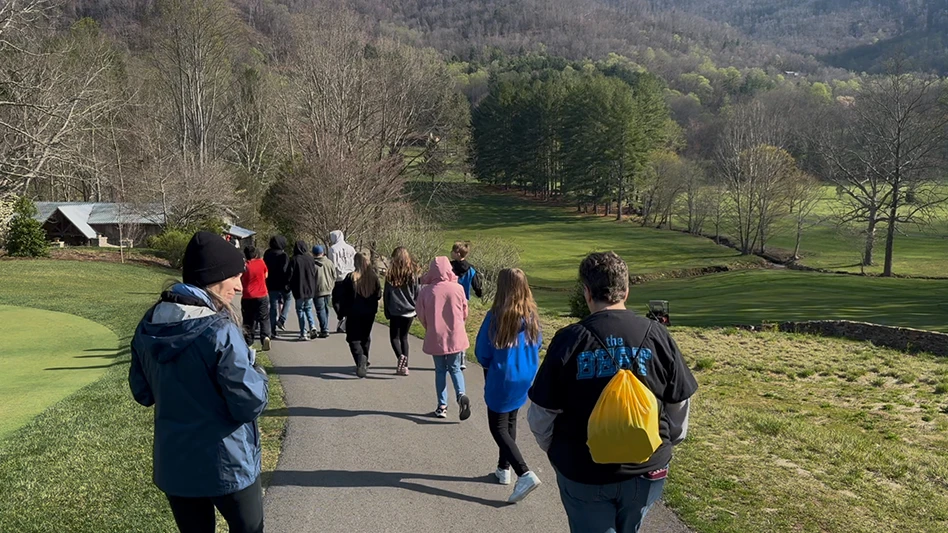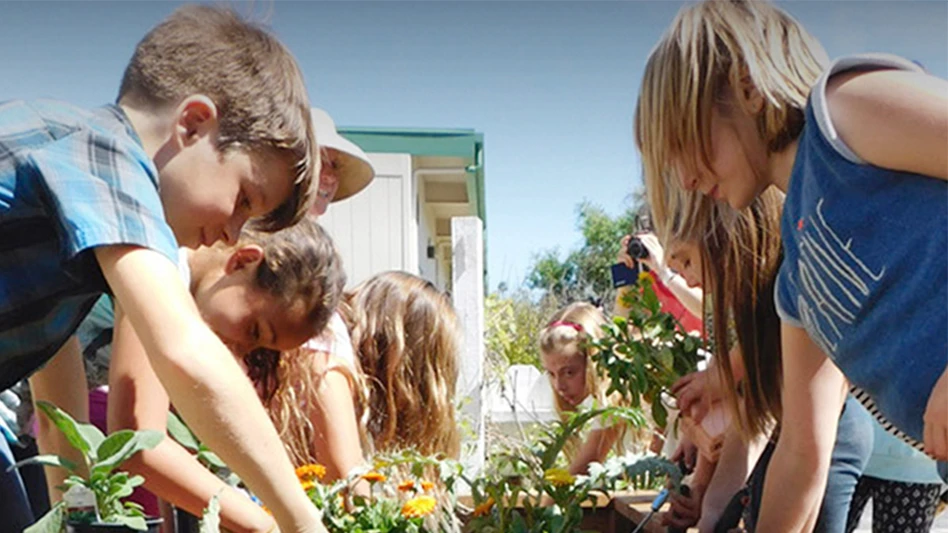
Superintendents never know what they will see when the snow and ice melts from their courses. With the pressure on to get the course in tip-top condition, there is precious little time to remedy damage and push green-up.
But … proceed with caution.“Promoting early turf growth in late winter and early spring to open early and generate income should be considered with caution and qualification,” advises Dr. Roch Gaussoin, professor of agronomy and horticulture at the University of Nebraska-Lincoln. “Regions that are prone to non-uniform temperature fluctuations may experience warming trends, where the superintendent increases growth and green-up only to get burned by a quick decrease in temperature, especially if coupled with snow or ice accumulation.”
Gaussoin says lush, actively growing turf is not acclimated to a sudden change in temperature and/or moisture and is highly susceptible to direct low temperature injury. “High winds, typical of many regions in the spring, in the absence of moisture, increases the probability of winter desiccation.”
Turf species is highly correlated with the degree of winterkill. Annual bluegrass, according to Gaussoin, is “far more” susceptible to injury due to crown hydration issues, direct low temperature injury and ice cover duration than creeping bentgrass. “Opening too early will cause significant traffic injury to the turf as it comes out of winter dormancy and increase the potential for more injury.” Regions with more “predictable” winter to spring transition can “buffer” the opening-for-play “dilemma” associated with these issues. But in northern areas where play is allowed all year, traffic associated with carts, maintenance equipment and even walkers intensifies winter injury.

Cold, open winters, especially if windy, can result in turf injury due to desiccation. “Ice cover is always a risk because crowns of the grass plant can freeze, and also because ice can impede gas exchange between the soil and atmosphere,” says Dr. Eric Miltner, agronomist, turf and ornamentals at Koch Turf and Ornamental. “It’s usually a good idea to try to remove ice cover if it happens.” Diseases, such as the various snow molds, are usually fairly easy to spot. Beyond that, superintendents need to keep an eye out for areas that are not greening up compared to surrounding turf, then investigate for underlying causes.
Identifying the cause of turf damage is the first step toward solving an unidentified problem. “Always remember your basic sound agronomic principles, such as soil management, mowing, fertility and nutrition, and pest management as the seasons change,” Miltner says. Some issues take a little patience as plants adjust to changing conditions. Try to not go overboard in addressing everything that seems unusual or different.
If the injury is extensive with appreciable turf loss, aggressive overseeding or even sodding may be needed. Aerification to alleviate compaction and improve surface drainage is often useful in avoiding winter injury in the future. Long term, improving surface drainage, especially in low areas where ice accumulation is a perennial problem, should be considered.
Frost, of course, is always problematic. Frost injury can be superficial, but it can also be long-lasting under the right (or wrong) conditions. “Be diligent about keeping traffic off frosty turf,” Miltner says. “Pushing too much growth and succulence could result in problems if that cold blast comes.”
About that pressure falling heavily on superintendents’ shoulders to get players onto the course? “We absolutely feel the pressure, but that is what this business is,” says Timothy Palko, grounds superintendent at Boulder Country Club in Colorado. “Weather dictates course conditions in the spring and your efforts will not beat Mother Nature.” While Palko says preventing all damage isn’t practical, reducing damage to a “reasonable” amount is always the goal. “In order to deal with that pressure, you must answer questions before they are asked. Letting others know you have a plan in place and are handicapped by the weather eases their emotions.”

James Ritorto, Northeast regional agronomist for Troon Golf says, “Superintendents want to get the course open for play as soon as possible,” but pressure can develop from a lack of understanding. “Most golfers do not understand the long-term damage that can occur from maintaining turf for play too early in the season. Communication and a mutual understanding of expectations are key to ensuring the best overall product.”
Practices that promote a healthy turf stand and warmer surface temperatures will assist in early season growth, Ritorto says, include the use of new turf varieties; a sound agronomic fall fertilization plan (which is crucial); increased sunlight through tree removal; heavy topdressing, specifically with darker sand; the use of covers; and the use of turf colorants.
Palko limits cart use to paths only from December through February. “Ball marks, divots that don’t heal until spring and other issues are part of being open in the winter in a climate where the ground freezes. If membership holds conditions to an incredibly high standard for spring, they can’t allow winter play. Helping membership understand the challenges you go through and explaining it helps highlight why you are so important to their club.”
Once his area gets an extended warm period in late February or early March, Palko has crews mow turf at a “very reduced” schedule. “Once we are at that point,” he says, “I feel confident we are through the window of snow mold pressure and I am more concerned with course cleanup and planning for repair where needed.”
Palko attempts to force turf out of dormancy “when the opportunity is there.” Mowing, brushing, soluble nitrogen applications and irrigation all play roles. “We can then assess whether we need to seed, sod, plug, punch or be patient and we try to get as much of that done as is reasonable before spring aerification”
“We all always feel pressure from ownership/management to open the golf courses,” says Scott Thayer, golf course superintendent at the Legends Golf Club in Minnesota, “but my ownership understands and agrees that the course is our No. 1 asset and pushing it can cause more damage than good.” He also recommends superintendents communicate as much as possible so their bosses understand the pros and cons of the possibilities of opening earlier than waiting. “Lay out all that could happen, have pictures of damage when opening early, and then let them make the final decision.”

According to Thayer, “rushing anything on a golf course” almost always is a danger in late winter/early spring because plants are so vulnerable with low soil temperatures and the plant not able to recover from anything that happens to it. The consequences can be dead or damaged turf, which can lead to serious problems.
To wit, Matthew Simon, golf course superintendent at Thendara Golf Club in New York, is “extremely cautious” with promoting turf growth: “The addition of growth regulators in my snow mold application hopefully slow down growth slightly in the spring. If things begin growing too early and then we get a sudden very cold snap, it can be devastating.”
Rick Tegtmeier, director of golf course maintenance at Des Moines Golf and Country Club in Iowa, says many superintendents in his area use turf covers for winter protection from the extreme temperature fluctuations. Leaving them on for a little longer time period in the spring can “jump start” bentgrass. “But in some instances,” he says, “you can leave them on too long, and if you experience a cold period, it could stunt or slow down growth.
“If you have an extended long period of cold weather with no snow cover, you can have some direct low temperature kill off the turf, especially Poa annua. Too warm, and the turf can start to initiate some growth, which is not what you want in the late winter period.”
Tegtmeier “has seen superintendents spread black sand or sunflower seeds on ice to absorb sunlight and open up the ice. Many superintendents keep the snow cleared from their greens if they are worried about freeze/thaw issues and too much free water sitting on the turf. Shoveling channels in the snow also works to move that water out of the way.”
Gaussoin says if conditions have been favorable for winterkill, proactive superintendents will take cup-cutter samples in late winter or early spring, place them in a south-facing window in a heated area, and “see what happens.” As the sample warms up, observing green up and subsequent growth helps the superintendent plan for spring operations. “The obvious desired outcome is a quick green up followed by active growth. If the core doesn’t green up, at least the superintendent can prepare the crew and golfers for needed steps to bring the turf back to playing conditions.”
“Getting the course ready should always be the superintendent’s call,” Penn State University turfgrass science professor Dr. Peter Landschoot says. “He or she has the knowledge and experience and knows the turf and soil conditions.” He advises not to push green up too forcefully through fertilization because “you may be pushing the growth of one type of grass over another” and get an uneven canopy as well as use up the plant’s food reserves too soon. In late winter, make sure there is no buildup or “puddling” of water, especially on greens and approaches. Small temporary channels can move away the water. Also, aerification should always be done when turf is growing so grass can recover quickly.
It’s always a balancing act, Mother Nature vs. man. Throw in management’s need to produce revenue in early spring and superintendents have their hands full. But when healthy turfgrass and long-term conditions are first on everyone’s priority list, the course — and the superintendent — will likely always win.

Explore the February 2020 Issue
Check out more from this issue and find your next story to read.
Latest from Golf Course Industry
- The Aquatrols Company hires marketing manager
- Renovating Bredemus in West Texas
- Renovation starts at Okatie Creek GC at Sun City Hilton Head
- The Fittest Podcast in Turf: Episode 1
- New 6-hole course debuts in Oklahoma
- GCSAA announces Grassroots Ambassador Leadership Award recipients
- Reel Turf Techs: David Gummo
- PBI-Gordon promotes two to executive level





